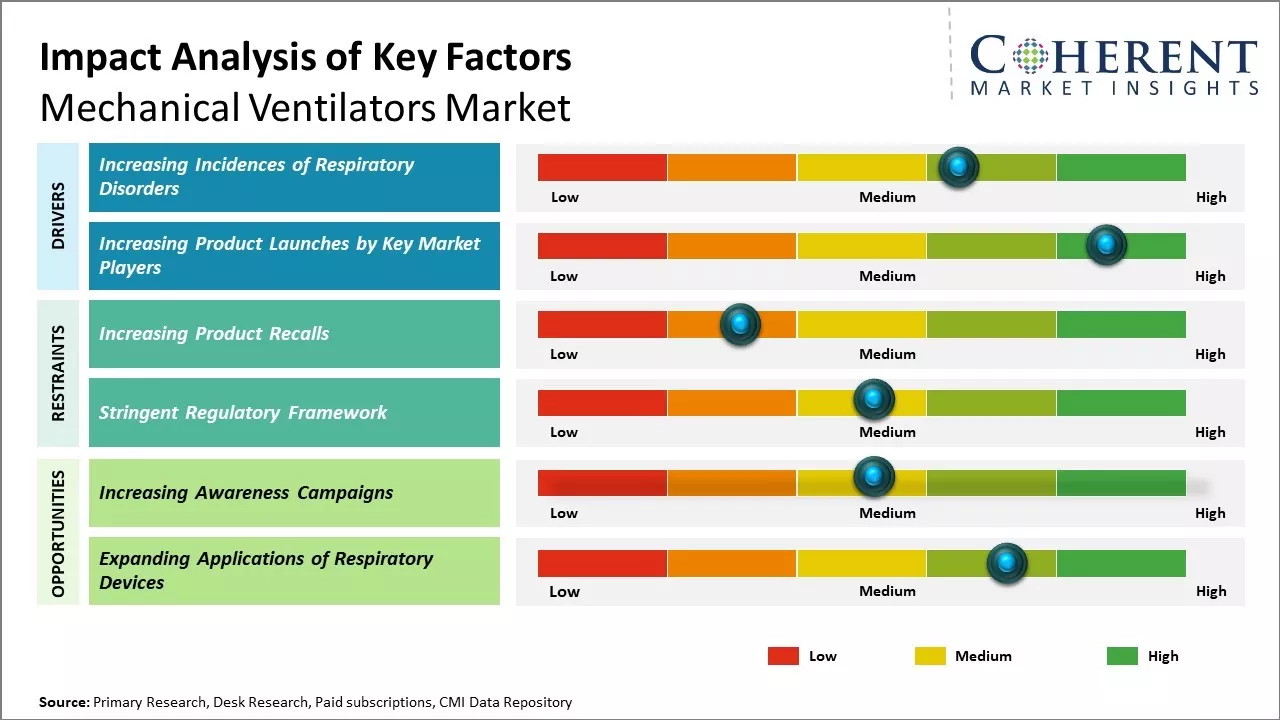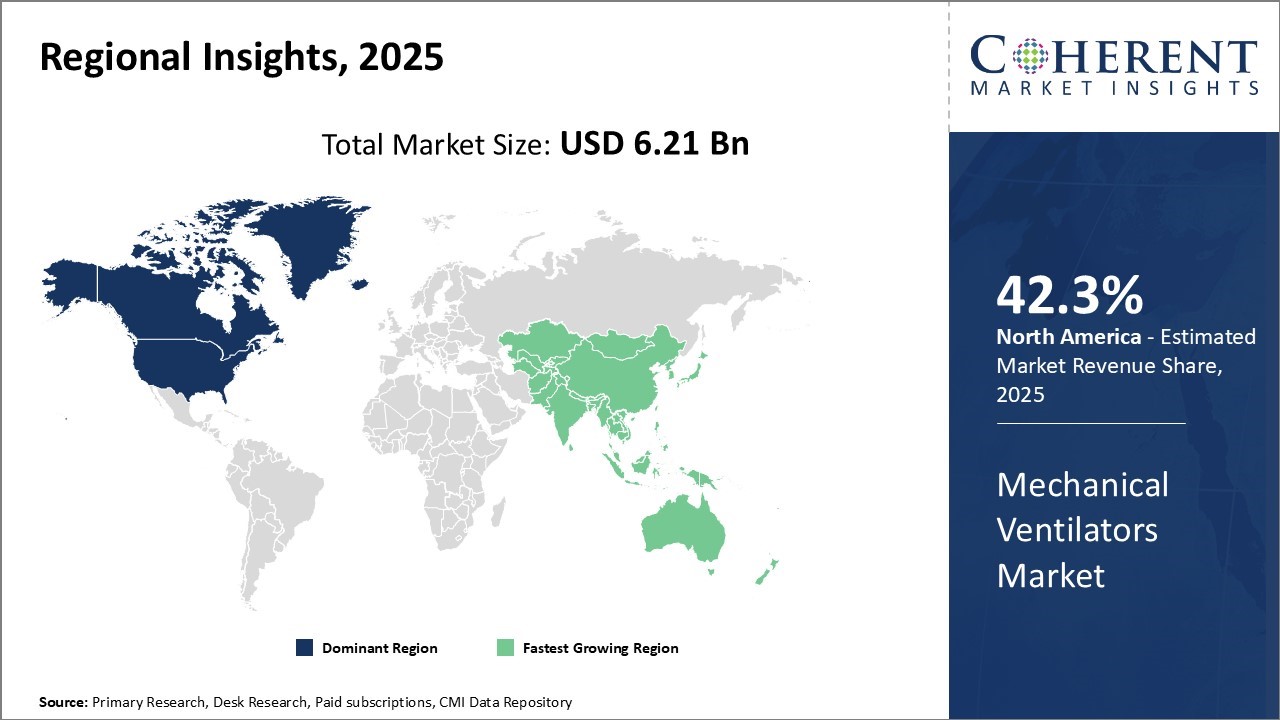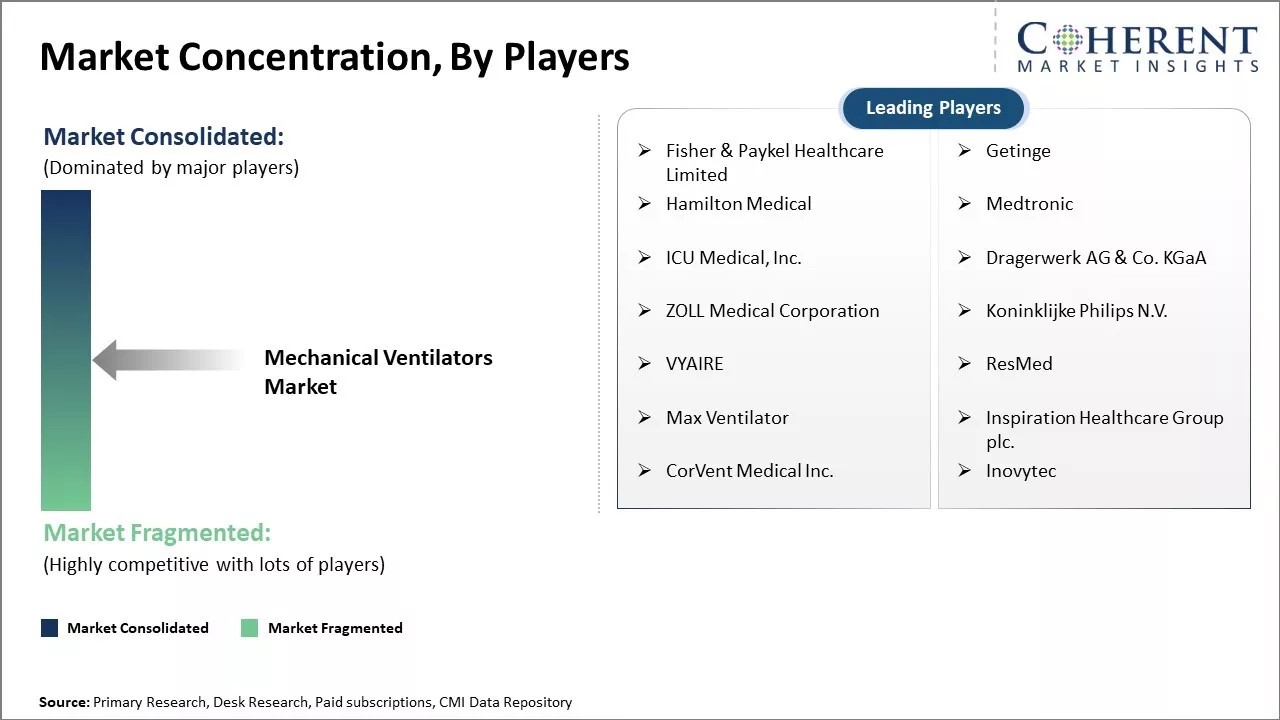The global mechanical ventilators market is estimated to be valued at USD 6.21 Bn in 2025 and is expected to reach USD 10.24 Bn by 2032, exhibiting a compound annual growth rate (CAGR) of 7.4% from 2025 to 2032.

To learn more about this report, Download Free Sample
The mechanical ventilators market demand continues to be driven by the rising incidence of respiratory diseases such as COPD, asthma, and acute respiratory distress syndrome (ARDS), particularly in aging populations. Technological advancements in ventilator design such as portability, non-invasive modes, and integrated monitoring features are encouraging adoption across hospitals, home care settings, and ambulatory surgical centers. The growing demand for intensive care units (ICUs) and critical care infrastructure in developing economies is further fueling market expansion. Additionally, government investments in emergency preparedness and increasing focus on healthcare accessibility in low- and middle-income countries are creating long-term growth opportunities for ventilator manufacturers worldwide.
|
Current Event |
Description and Its Impact |
|
Regulatory Transitions in Key Markets |
|
|
Technological Innovations |
|
Uncover macros and micros vetted on 75+ parameters: Get instant access to report
A recent development significantly influencing the mechanical ventilators market forecast is the updated reimbursement policy by the Centers for Medicare & Medicaid Services (CMS) in the United States. In June 2025, CMS issued a final National Coverage Determination (NCD) that expands Medicare coverage for home mechanical ventilators (HMVs) and respiratory assist devices (RADs) used in the management of chronic respiratory failure, particularly in patients with conditions like COPD. This policy eliminates previous inconsistencies across regional Medicare contractors, making access to ventilators more predictable and uniform across the country.
The updated policy allows for coverage of RADs with backup rate features and HMVs in volume-targeted modes when prescribed under clearly defined clinical criteria, such as elevated PaCO₂ levels or documented failure with RAD therapy alone. Importantly, patients no longer need to undergo a trial with non-backup RADs before qualifying for home mechanical ventilation. Coverage begins immediately upon discharge and is renewable every six months based on clinical reassessment. In addition, CMS introduced new billing codes like E0468 for ventilators with dual functionality, offering clearer reimbursement pathways for advanced devices.
In terms of product type, the critical care mechanical ventilators segment is estimated to hold 57.4% of the market share in 2025 owing to high demand from ICUs and emergency departments. Critical care ventilators are specifically designed to support life for patients suffering from severe respiratory disease or trauma. Their advanced functionality and monitoring capabilities make them indispensable for high-acuity respiratory support. This segment has seen rising demand due to the growing prevalence of chronic respiratory conditions worldwide. Diseases like chronic obstructive pulmonary disease (COPD), asthma, respiratory infections, and cystic fibrosis all require critical ventilator support at some point. An aging global population is another factor, as respiratory health generally declines with age.
In July 2024, Air Liquide Medical Systems launched the Monnal™ TEO, its latest resuscitation ventilator designed and manufactured in France for use in intensive and critical care. The Monnal™ TEO offers advanced respiratory support tailored for emergency and hospital settings. The launch underscores Air Liquide’s commitment to enhancing critical-care ventilation with domestically produced medical technology. This is further contributing to the mechanical ventilators market share.
In terms of end user, the hospitals segment is estimated to hold 32.9% of the market share in 2025. This is because they are treating the most severe respiratory cases requiring intensive ventilator therapy. Large hospital ICU and emergency departments house scores of ventilated patients at any given time. Public hospitals especially have heavy ventilation caseloads, as they are mandated to treat all patients regardless of their ability to pay. The acute care setting within hospitals also demands highly featured critical care ventilators capable of precise, continuous respiratory support. Portable and home-use ventilators do not offer the same monitoring sophistication required in hospital floors.
In March 2025, IMT Innovations debuted its new mechanical ventilator prototype, dubbed “box”—designed for critical-care and subacute hospital settings. It features a compact, user-friendly design, the device supports intensive-care and adaptable patient modes while prioritizing safety and ease of use, further positively influencing the mechanical ventilators market forecast.

To learn more about this report, Download Free Sample
North America remains the dominant region in the global mechanical ventilators market and is estimated to hold 42.3% of the market share in 2025 due to a high prevalence of chronic respiratory conditions such as COPD, asthma, and sleep apnea. The aging population, combined with the rising incidences of lifestyle-related illnesses, is driving the need for long term care. Advanced healthcare infrastructure, favorable reimbursement policies, and strong government support for critical care technologies also play key roles. In addition, growing investments in ICU capacity and the integration of AI-driven ventilators in top-tier hospitals further accelerate regional adoption.
In 2025, U.S.-based Medtronic expanded its production of portable and intelligent ventilator systems to meet rising demand across hospitals and home-care settings.
In October 2024, Nihon Kohden America unveiled the FDA‑cleared NKV‑440 ventilator system, now available beyond its OrangeMed subsidiary. This turbine‑driven device provides invasive and non‑invasive ventilation alongside high‑flow oxygen therapy, all in a single compact unit. It operates without the need for wall air or compressors, enhancing portability and reducing maintenance costs.
Asia Pacific region is expected to exhibit the fastest growth in the market during the forecast period, propelled by the multiple healthcare and demographic factors. Rapid population growth, especially the rising proportion of elderly individuals, has led to a higher prevalence of chronic respiratory diseases such as COPD and asthma. Countries like India, China, and Indonesia are experiencing increasing hospital admissions for respiratory infections and critical care needs, driving demand for both invasive and non-invasive ventilators.
Moreover, expanding government investments in public health infrastructure and intensive care units (ICUs) across emerging economies are accelerating the adoption of advanced ventilator systems. The region’s medical device manufacturing ecosystem is also growing, leading to cost-effective production and accessibility.
In 2025, India’s Ministry of Health launched new funding to upgrade ICU facilities across tier-2 and tier-3 cities under its National Health Mission, significantly increasing procurement of portable and ICU ventilators from local and global suppliers. This is further proliferating the mechanical ventilators market share.
The United States remains a major demand center for mechanical ventilators due to its highly advanced critical care infrastructure and a significant burden of chronic respiratory diseases, such as COPD, asthma, and sleep apnea. According to the CDC, over 16 million Americans are diagnosed with COPD alone, and millions more remain undiagnosed. Additionally, an aging population with increasing ICU admissions and post-operative respiratory support needs further fuels mechanical ventilators demand.
For instance, the U.S. Department of Health and Human Services (HHS), through agencies such as ASPR (Assistant Secretary for Preparedness and Response), actively supports the strategic stockpiling and procurement of mechanical ventilators. In recent years, HHS has allocated funding towards not just purchasing standard ventilators but also accelerating innovation in portable, user-friendly, and rapidly deployable ventilators.
Japan’s mechanical ventilators market remains at the forefront globally due to its aging population (28% aged 65+), high ICU bed density, and growing respiratory illness burden drive strong ventilator demand. The country also promotes medical device innovation through supportive regulations and R&D incentives. The government has increased domestic ventilator procurement to strengthen emergency readiness. Local manufacturers are developing smart ventilators with AI and remote monitoring, aligning with Japan’s push toward smart hospital infrastructure and improved rural healthcare access.

To learn more about this report, Download Free Sample
| Report Coverage | Details | ||
|---|---|---|---|
| Base Year: | 2024 | Market Size in 2025: | USD 6.21 Bn |
| Historical Data for: | 2020 To 2024 | Forecast Period: | 2025 To 2032 |
| Forecast Period 2025 to 2032 CAGR: | 7.4% | 2032 Value Projection: | USD 10.24 Bn |
| Geographies covered: |
|
||
| Segments covered: |
|
||
| Companies covered: |
Fisher & Paykel Healthcare Limited, Getinge, Hamilton Medical, Medtronic, ICU Medical, Inc., Dragerwerk AG & Co. KGaA, ZOLL Medical Corporation, Koninklijke Philips N.V., VYAIRE, ResMed, Max Ventilator, Inspiration Healthcare Group plc., CorVent Medical Inc., and Inovytec |
||
| Growth Drivers: |
|
||
| Restraints & Challenges: |
|
||
Uncover macros and micros vetted on 75+ parameters: Get instant access to report
The global respiratory devices market is being driven higher by the increasing prevalence of various respiratory diseases worldwide. Conditions such as chronic obstructive pulmonary disease (COPD) and asthma continue affecting millions of people and are major health issues in both developed and developing countries. Chronic obstructive pulmonary disease (COPD) in particular has risen to become a leading cause of death globally in recent years. The high instance of respiratory illnesses can be attributed to factors like rising air pollution levels, growing elderly population, and changing lifestyles involving smoking and lack of physical activity. For instance, according to the World Health Organization fact sheet released in March 2023, over 200 million individuals are affected by chronic obstructive pulmonary disease (COPD), causing 3.23 million deaths in 2019 and 65 million experiencing moderate-to-severe COPD. Moreover, sleep-disordered breathing affects around 1-6% of the adult population, which amounts to more than 100 million people.
The urgent need to address this growing respiratory disease burden through effective therapeutic and diagnostic solutions is a key mechanical ventilators market growth catalyst. Device manufacturers are ramping up their product portfolios to meet the provider demand arising from the expanding patient pools.
Awareness campaigns by governments, healthcare organizations, and NGOs are playing a critical role in educating both medical professionals and the public about the importance of timely respiratory support and critical care readiness. These initiatives are particularly impactful in developing regions where underdiagnosis of respiratory conditions like COPD, sleep apnea, and ARDS is prevalent. In July 2025, to mark World Bronchiectasis Day, the American Lung Association is launching a new initiative to support individuals living with bronchiectasis—a chronic and progressive lung disease that affects an estimated 350,000 to 500,000 adults in the U.S. The campaign’s goal is to provide education on better disease management, offer emotional support resources, and ultimately enhance the quality of life for those affected.
As a result, these awareness efforts are expected to significantly influence the mechanical ventilators market forecast, contributing to expanded market penetration, especially in emerging economies where adoption was previously limited due to low awareness and inadequate training. This is further propelling the mechanical ventilators market revenue.
*Definition: A mechanical ventilator is a machine or device that helps to breathe and partially or completely supports the functions of the lungs. Ventilator helps to remove carbon dioxide from the lungs and provides oxygen to the body. It also provides pressure to keep the small air sacks in the lungs from collapsing. Mechanical ventilation is a form of life support that helps to breathe (ventilate) when a person cannot breathe on own during surgery.
Share
Share
About Author
Manisha Vibhute is a consultant with over 5 years of experience in market research and consulting. With a strong understanding of market dynamics, Manisha assists clients in developing effective market access strategies. She helps medical device companies navigate pricing, reimbursement, and regulatory pathways to ensure successful product launches.
Missing comfort of reading report in your local language? Find your preferred language :
Transform your Strategy with Exclusive Trending Reports :
Frequently Asked Questions
Joining thousands of companies around the world committed to making the Excellent Business Solutions.
View All Our Clients